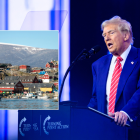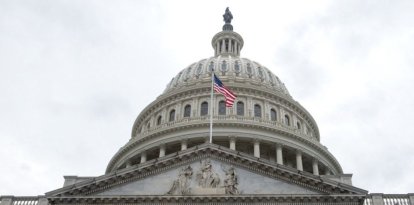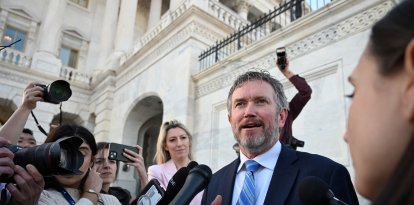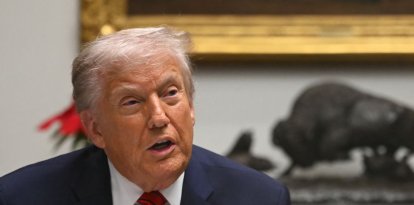Trump and an old diplomatic yearning: The four times the United States wanted to acquire Greenland
Prior to Trump's arrival, the White House was interested in the world's largest island on several occasions, even going as far as bidding $100 million in 1946.
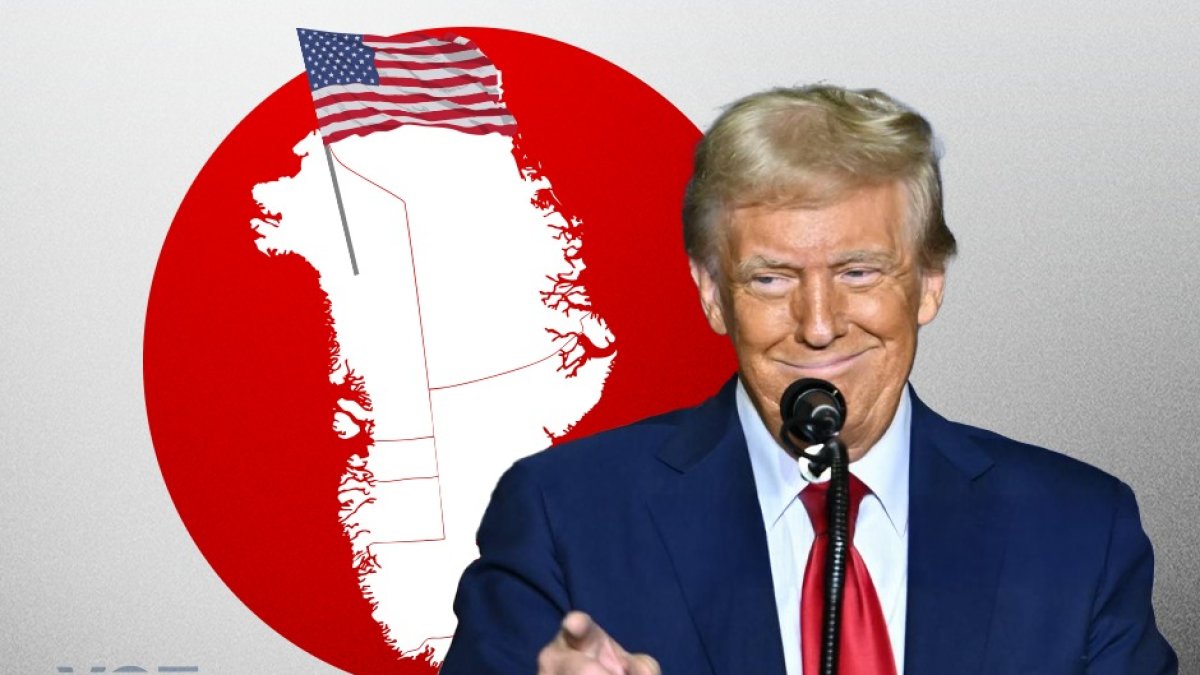
Acquiring Greenland is one of Trump's diplomatic priorities/Angela Weiss.
"For purposes of National Security and Freedom throughout the World, the United States of America feels that the ownership and control of Greenland is an absolute necessity," Donald Trump wrote last December 22 on his Truth Social account. This was an addendum to the post he used to announce the nomination of Ken Howery as the next ambassador to the Kingdom of Denmark.
Since then, the president-elect has repeatedly emphasized the need to acquire the "largest island in the world." He even sent his son, Donald Trump Jr., to the place where he dialogued with the locals and showed them a message from his father.
Greenland has a land area slightly larger than Mexico, and 80% of it is covered by ice. Its population is approximately 57,000, most of whom live from fishing and hunting.
Its attractiveness has to do with its strategic position in the Arctic and with the appearance of natural resources. With ice melting in recent years, it is estimated that the island has the largest deposits of rare earth after China. These minerals can be used to manufacture computers, electric cars and wind turbines, among many other things.
A reaction from the Danish government did not take long. Mette Frederiksen, prime minister of Denmark, assured that "Greenland belongs to the Greenlanders." "On one hand, I am pleased regarding the rise in American interest in Greenland. But of course, it is important that it takes place in a way that is the Greenlanders’ decision, what their future holds," she added.
However, Trump did not rule out using military or economic force to ultimately keep Greenland. "I’m not going to commit to that, no. It might be that you’ll have to do something," he told a reporter during a press conference at Mar-a-Lago.
Although he had already suggested this idea in 2019, Trump is very clear about his intention to incorporate the snow-covered island in his next and final term. However, this is not the first time in history that the U.S. has shown interest in Greenland.
1867: William H. Seward's passing temptation
In October 1867, the United States bought Alaska from Russia for about $7.2 million, the equivalent of nearly $130 million in 2023. William H. Seward, then secretary of state in the Johnson administration, led the negotiations.
That same year, Seward evaluated the possibility of acquiring Iceland and Greenland. This was stated in a report, "A Report on the Resources of Iceland and Greenland," which Seward commissioned to analyze the possible benefits of purchasing these territories.
This document praised Greenland for its "unusual salubrity," its abundance of game, fish and exploitable natural resources. Ultimately, it proved to be a passing temptation for Seward, as he never got around to sending the Kingdom of Denmark a formal offer.
1910: The first formal offer
In 1905, Norway gained independence from Sweden and began claiming certain territorial rights over Greenland, an island that had previously belonged to it. This triggered tension with Denmark by 1910.
Eager to capitalize on this situation diplomatically, President William Howard Taft asked his ambassador to Denmark, Maurice Francis Egans, to make a formal offer.
"Greenland is looked on by the Danes very much as our people formerly looked on Alaska. The Government here is so much occupied with internal economic and political differences in Denmark that it gives very little attention to the development of the resources of Greenland, which is practically terra incognita," Egans wrote about the island at the time.
In effect, the United States proposed a modest barter: Greenland in exchange for the Philippine island of Mindanao, Palau and another set of islands to the south. Egans' intentions did not come to fruition and Greenland remained under Danish control, although more chapters of this novel are still to come.
1947: 100 million in gold bullion
During the Second World War, Germany invaded Denmark in 1940 and created uncertainty over Greenland, given its relative proximity to the United States. In April 1941, Henrik Kauffmann, the Danish ambassador to Washington, signed a treaty authorizing the installation of military bases on the island, which led to the creation of the Thule air base.
John Hickerson, a State Department official, attended a meeting of the planning and strategy committee of the Joint Chiefs of Staff in 1946. As he recounted, "practically every member said that our real objective as regards to Greenland should be to acquire it by purchase from Denmark."
"The committee indicated that money is plentiful now, that Greenland is completely worthless to Denmark (and) that the control of Greenland is indispensable to the safety of the United States," Hickerson added.
After the war ended, Secretary of State James F. Byrnes offered $100 million in gold bullion to buy Greenland. Byrnes formalized the offer through a memorandum he gave to then-Danish Foreign Minister Gustav Rasmussen in December 1946.
"Our needs ... seemed to come as a shock to Rasmussen, but he did not reject my suggestions flatly and said that he would study a memorandum which I gave him," Byrnes wrote at the time. This document contained three different alternatives: a 99-year lease of the military bases, the U.S. taking over the total defense of Greenland, and an outright purchase.


Politics
Trump announces he will give the Gulf of Mexico a 'more beautiful and appropriate' name
Joaquín Núñez
The proposal took Rasmussen entirely by surprise since he had been informed that the idea of buying Greenland was an eccentricity proposed by some White House officials and did not meet with the approval of President Harry Truman.
By 2025, there is no consensus on whether the Danish government rejected the offer or simply did not respond, but the outcome left little doubt: Greenland remained under its control. The offer was classified information until the 1970s when the Danish media Jyllands-Posten reported on it in 1991.
Regarding the future of military bases, the U.S. Air Force currently maintains two in Greenland: Thule and Sondestrom.
2019: Trump is back on the charge for Greenland
The desire to acquire Greenland lay dormant for nearly seventy years until Donald Trump refloated the idea in 2018.
According to the book "The Divider" by Peter Baker and Susan Glasser, Ron Lauder initially proposed the purchase to Trump. The businessman and Trump's longtime friend was an ambassador during the Reagan administration and currently serves as president of the World Jewish Congress.
Trump, who had reportedly mulled the purchase in the past, ran the idea past John Bolton, his then-national security adviser. "A friend of mine, a very, very experienced businessman, thinks we can get Greenland. What do you think?" he told Bolton according to Baker and Glasser's book. The official then assigned Fiona Hill to study its possibilities.
"I said, 'Why don't we have that?' You take a look at a map. I'm a real estate developer. I look at a corner, I say, 'I've got to get that store for the building that I'm building,' etc. It's not that different. I love maps. And I always said: 'Look at the size of this. It's massive. That should be part of the United States,'" Trump noted in a series of interviews for Baker and Glasser's book.
When the Wall Street Journal reported on Trump's plans, Danish leaders responded with a strong negative, prompting the Republican to cancel a state visit to Denmark originally planned for late 2019.
2025: Trump 2.0
Just 48 hours after Trump's win over Kamala Harris, Congressman Mike Collins (R-GA) refloated the idea of acquiring Greenland.
The Georgia Republican posted an image of the electoral map on his X account, showing Greenland dyed red. "Project 2029," Collins wrote. The post went viral, surpassing four million retweets on Elon Musk's social network.
The president-elect himself his intentions with the aforementioned announcement of Howery as ambassador, formally resuming this diplomatic novel with no apparent end.
With the start of the second Trump administration drawing near, it is clear that the Republican has Greenland among his main foreign policy objectives. We will have to wait to see if he succeeds in nailing the U.S. flag to the so-called largest island in the world.





